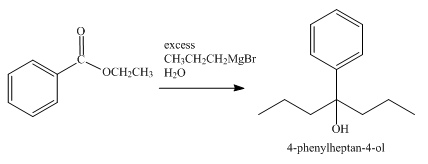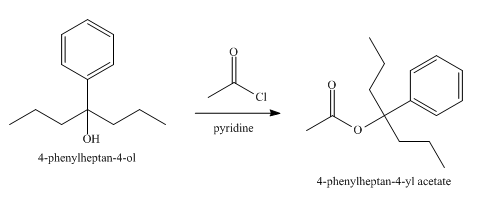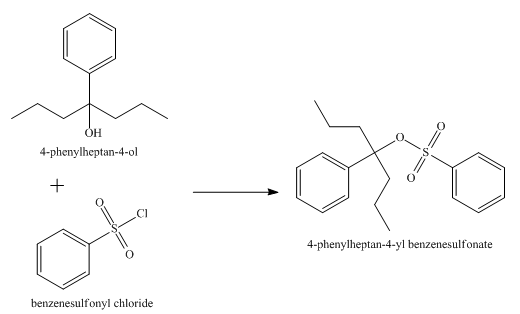
Concept explainers
(a)
Interpretation:
The product obtained from the reaction of ethyl benzoate and
Concept introduction:
An ester is a derivative of carboxylic which is obtained by replacing the
Answer to Problem 21.32AP
The product obtained from the reaction of ethyl benzoate and

Explanation of Solution
The reaction of ethyl benzoate in presence

Figure 1
The product obtained from the reaction of ethyl benzoate and
(b)
Interpretation:
The product obtained from the reaction of ethyl benzoate and
Concept introduction:
An ester is a derivative of carboxylic which is obtained by replacing the
Answer to Problem 21.32AP
The product obtained from the reaction of ethyl benzoate and

Explanation of Solution
The reaction of ethyl benzoate in the presence of

Figure 2
The product obtained from the reaction of ethyl benzoate and
(c)
Interpretation:
The product obtained from the reaction of ethyl benzoate and aqueous
Concept introduction:
An ester is a derivative of carboxylic which is obtained by replacing the
Answer to Problem 21.32AP
The product obtained from the reaction of ethyl benzoate and aqueous

Explanation of Solution
The reaction of ethyl benzoate in the presence of aqueous

Figure 3
The product obtained from the reaction of ethyl benzoate and aqueous
(d)
Interpretation:
The product obtained from the reaction of ethyl benzoate and
Concept introduction:
An ester is a derivative of carboxylic which is obtained by replacing the
Answer to Problem 21.32AP
The product obtained from the reaction of ethyl benzoate and

Explanation of Solution
The reduction reaction of ethyl benzoate takes place in the presence of

Figure 4
The product obtained from the reaction of ethyl benzoate and
(e)
Interpretation:
The product obtained from the reaction of ethyl benzoate and excess
Concept introduction:
An ester is a derivative of carboxylic which is obtained by replacing the
Answer to Problem 21.32AP
The product obtained from the reaction of ethyl benzoate and excess

Explanation of Solution
The reaction of ethyl benzoate with an excess of Grignard reagent

Figure 5
The product obtained from the reaction of ethyl benzoate and excess
(f)
Interpretation:
The product obtained from the reaction of the product of part (e) and acetyl chloride, pyridine at
Concept introduction:
An ester is a derivative of carboxylic which is obtained by replacing the
Answer to Problem 21.32AP
The product obtained from the reaction of the product of part (e) and acetyl chloride, pyridine, at

Explanation of Solution
The reaction of the product of part (e) and acetyl chloride, pyridine at

Figure 6
The product obtained from the reaction of the product of part (e) and acetyl chloride, pyridine, at
(g)
Interpretation:
The product obtained from the reaction of the product of part (e) and benzenesulfonyl chloride is to be stated.
Concept introduction:
An ester is a derivative of carboxylic which is obtained by replacing the
Answer to Problem 21.32AP
The product obtained from the reaction of the product of part (e) and benzenesulfonyl chloride is shown below.

Explanation of Solution
The reaction of the product of part (e) and benzenesulphonyl chloride undergoes substitution reaction. It results in the formation of

Figure 7
The product obtained from the reaction of the product of part (e) and benzenesulfonyl chloride is shown in Figure 7.
(h)
Interpretation:
The product obtained from the reaction of ethyl benzoate and
Concept introduction:
An ester is a derivative of carboxylic which is obtained by replacing the
Answer to Problem 21.32AP
The product obtained from the reaction of ethyl benzoate and

Explanation of Solution
The reaction of ethyl benzoate with

Figure 8
The product obtained from the reaction of ethyl benzoate and
Want to see more full solutions like this?
Chapter 21 Solutions
Organic Chemistry
- Identify the compound with the longest carbon - nitrogen bond. O CH3CH2CH=NH O CH3CH2NH2 CH3CH2C=N CH3CH=NCH 3 The length of all the carbon-nitrogen bonds are the samearrow_forwardIdentify any polar covalent bonds in epichlorohydrin with S+ and 8- symbols in the appropriate locations. Choose the correct answer below. Η H's+ 6Η Η Η Η Η Ηδ Η Ο Ο HH +Η Η +Η Η Η -8+ CIarrow_forwardH H:O::::H H H HH H::O:D:D:H HH HH H:O:D:D:H .. HH H:O:D:D:H H H Select the correct Lewis dot structure for the following compound: CH3CH2OHarrow_forward
- Rank the following compounds in order of decreasing boiling point. ннннн -С-С-Н . н-с- ННННН H ΗΤΗ НННН TTTĪ н-с-с-с-с-о-н НННН НН C' Н н-с-с-с-с-н НН || Ш НННН H-C-C-C-C-N-H ННННН IVarrow_forwardRank the following compounds in order of decreasing dipole moment. |>||>||| ||>|||>| |>|||>|| |||>||>| O ||>>||| H F H F H c=c || H c=c F F IIIarrow_forwardchoose the description that best describes the geometry for the following charged species ch3-arrow_forward
- Why isn't the ketone in this compound converted to an acetal or hemiacetal by the alcohol and acid?arrow_forwardWhat is the approximate bond angle around the nitrogen atom? HNH H Harrow_forwardOH 1. NaOCH2CH3 Q 2. CH3CH2Br (1 equiv) H3O+ Select to Draw 1. NaOCH2 CH3 2. CH3Br (1 equiv) heat Select to Edit Select to Drawarrow_forward
- Complete and balance the following half-reaction in acidic solution. Be sure to include the proper phases for all species within the reaction. S₂O₃²⁻(aq) → S₄O₆²⁻(aq)arrow_forwardQ Select to Edit NH3 (CH3)2CHCI (1 equiv) AICI 3 Select to Draw cat. H2SO4 SO3 (1 equiv) HO SOCl2 pyridine Select to Edit >arrow_forwardComplete and balance the following half-reaction in basic solution. Be sure to include the proper phases for all species within the reaction. Zn(s) → Zn(OH)₄²⁻(aq)arrow_forward
 Chemistry: Principles and ReactionsChemistryISBN:9781305079373Author:William L. Masterton, Cecile N. HurleyPublisher:Cengage Learning
Chemistry: Principles and ReactionsChemistryISBN:9781305079373Author:William L. Masterton, Cecile N. HurleyPublisher:Cengage Learning
